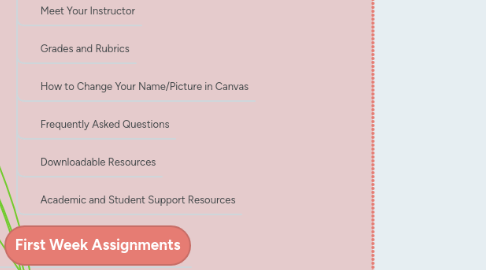
1. Embedded welcome page
1.1. Syllabus
1.2. Announcement List
1.3. Modules
2. Announcements
3. Modules
3.1. Course Introduction
3.1.1. Getting Started
3.1.2. Syllabus
3.1.3. Intellectual Property Statement
3.1.4. Meet Your Instructor
3.1.5. Grades and Rubrics
3.1.6. How to Change Your Name/Picture in Canvas
3.1.7. Frequently Asked Questions
3.1.8. Downloadable Resources
3.1.9. Academic and Student Support Resources
3.2. First Week Assignments
3.2.1. Pretest
3.2.2. Syllabus Agreement
3.2.3. Introduce Yourself
3.3. Your Discussions
3.3.1. Exercise Help
3.3.2. Open Discussion
3.4. Lesson 1: Research Strategies
3.4.1. Part 1: Choosing a Topic
3.4.2. Part 2: Stating a Research Topic as a Thesis
3.4.3. Part 3: Identifying Keywords
3.4.4. Part 4: Building a Search Statement - Boolean Operators
3.4.5. Part 5: Building a Search Statement - Nesting and Phrase Searching
3.4.6. Part 6: Putting It All Together
3.4.7. Lesson 1 Practice Questions
3.4.8. Exercise #1
3.5. Project Topic
3.5.1. Project Topic Instructions
3.5.2. Suggestions for Project Topics
3.5.3. Project Topic Submission Form
3.6. Lesson 2: Search Engines
3.6.1. Part 1: How Do Search Engines Work?
3.6.2. Part 2: Popular Search Engines
3.6.3. Part 3: Search Basics
3.6.4. Part 4: Web Page Basics
3.6.5. Part 5: Field Searching
3.6.6. Part 6: More on Google
3.6.7. Lesson 2 Practice Questions
3.6.8. Exercise #1
3.6.9. The "Filter Bubble"
3.7. Lesson 3: Specialized Web Searching
3.7.1. Part 1: Advanced Search
3.7.2. Part 2: Multimedia Files
3.7.3. Part 3: Image Searching
3.7.4. Part 4: Video Searching
3.7.5. Part 5: Google Scholar
3.7.6. Lesson 3 Practice Questions
3.7.7. Exercise #3
3.7.8. Instructions: Search Engine Expert Assignment
3.8. Lesson 4: Evaluating Internet Resources
3.8.1. Part 1: Authority
3.8.2. Part 2: Accuracy
3.8.3. Part 3: Bias
3.8.4. Part 4: Currency
3.8.5. Part 5: Sample Analysis of a Website
3.8.6. Lesson 4 Practice Questions
3.8.7. Exercise #4
3.8.8. Misinformation in the Internet Age
3.9. Lesson 5: Relevancy
3.9.1. Part 1: Coverage
3.9.2. Part 2: Types of Information
3.9.3. Part 3: Evaluation Based on Coverage
3.9.4. Part 4: Conclusions and Relevance to a Thesis
3.9.5. Lesson 5 Practice Questions
3.9.6. Exercise #5
3.10. Lesson 6: Library Databases
3.10.1. Part 1: What are Library Databases?
3.10.2. Part 2: Accessing Library Databases
3.10.3. Part 3: Selecting Appropriate Databases
3.10.4. Part 4: Using Databases
3.10.5. Part 5: Database Content
3.10.6. Lesson 6 Practice Questions
3.10.7. Exercise #6
3.11. Lesson 7: Citing Internet Resources
3.11.1. Part 1: Preventing Plagiarism
3.11.2. The Growing Problem of Plagiarism (wiki page)
3.11.3. Part 2: Citation Styles
3.11.4. Part 3: Identifying Citation Components
3.11.5. Part 4: Citing Web Pages - MLA & APA
3.11.6. Part 5: Citing Articles from Databases - MLA & APA
3.11.7. Part 6: Library Database Generated Citations
3.11.8. Part 7: In-Text Citations
3.11.9. Lesson 7 Practice Questions
3.11.10. Exercise #7
3.11.11. Post Your Search Engine Expert Assignment
3.12. Make-Up Exercise
3.12.1. Make-Up Exercise (optional)
3.13. Extra Credit
3.13.1. Research in Real Life (IRL) - Extra Credit
3.14. Project Instructions
3.14.1. Project Instructions and Rubric
3.14.2. Project Questions
3.14.3. Example of Completed Project
3.14.4. Resource for the Project [text header]
3.14.4.1. Inserting Images in Word Processing Programs
3.14.4.2. Hanging Indents in Word Processing Programs
3.15. Upload Project Here
3.15.1. Project Rubric
3.15.2. Upload Project Here
3.16. Exam
3.16.1. Submit an Exam Question
3.16.2. Exam Information
3.16.3. Exam
